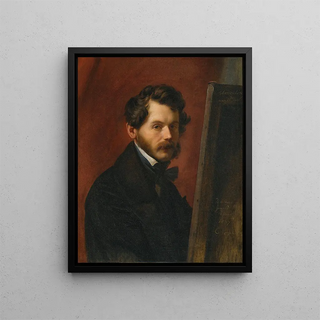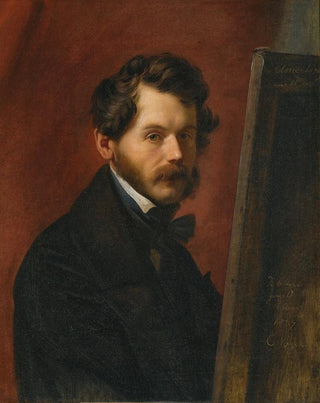Art print | Friedrich von Amerling - Carl Christian Vogel von Vogelstein


View from behind

Frame (optional)
In the world of art, some works transcend time and space, captivating viewers and evoking emotions. The art print Friedrich von Amerling - Carl Christian Vogel von Vogelstein is one of those pieces that, through its charm and depth, invites prolonged contemplation. This portrait, highlighting the finesse of features and the delicacy of colors, is a true homage to the spirit of the 19th century, an era when art reflected society's aspirations and values. The encounter between the subject, Carl Christian Vogel von Vogelstein, and the artist, Friedrich von Amerling, gives rise to a work that does not merely depict but tells a story — that of a man and his era.
Style and uniqueness of the work
Friedrich von Amerling's style is characterized by remarkable meticulousness and particular attention to detail. In this portrait, mastery of light and shadow creates an intimate atmosphere, where each element is carefully designed to highlight the subject. The colors, both soft and vibrant, testify to a refined palette, while the balanced composition gives the piece a striking visual harmony. Vogelstein's posture, both relaxed and confident, reflects the personality of the man, an artist of his time, whose intellect and sensitivity shine through every brushstroke. This portrait is not just a simple representation; it is a true psychological study, where the artist manages to capture the very essence of his model.
The artist and his influence
Friedrich von Amerling, an emblematic figure of Austrian art, established himself through his talent and artistic vision. Trained in the ateliers of great masters, he developed a unique style, blending classical influences with contemporary innovations. His work is marked by a constant pursuit of beauty and truth, values that resonate deeply in the portrait of Carl Christian Vogel von Vogelstein. Amerling not only influenced his contemporaries but also paved the way for new generations of artists, teaching them the importance of emotion and psychology in human representation. By capturing the soul of

Matte finish

View from behind

Frame (optional)
In the world of art, some works transcend time and space, captivating viewers and evoking emotions. The art print Friedrich von Amerling - Carl Christian Vogel von Vogelstein is one of those pieces that, through its charm and depth, invites prolonged contemplation. This portrait, highlighting the finesse of features and the delicacy of colors, is a true homage to the spirit of the 19th century, an era when art reflected society's aspirations and values. The encounter between the subject, Carl Christian Vogel von Vogelstein, and the artist, Friedrich von Amerling, gives rise to a work that does not merely depict but tells a story — that of a man and his era.
Style and uniqueness of the work
Friedrich von Amerling's style is characterized by remarkable meticulousness and particular attention to detail. In this portrait, mastery of light and shadow creates an intimate atmosphere, where each element is carefully designed to highlight the subject. The colors, both soft and vibrant, testify to a refined palette, while the balanced composition gives the piece a striking visual harmony. Vogelstein's posture, both relaxed and confident, reflects the personality of the man, an artist of his time, whose intellect and sensitivity shine through every brushstroke. This portrait is not just a simple representation; it is a true psychological study, where the artist manages to capture the very essence of his model.
The artist and his influence
Friedrich von Amerling, an emblematic figure of Austrian art, established himself through his talent and artistic vision. Trained in the ateliers of great masters, he developed a unique style, blending classical influences with contemporary innovations. His work is marked by a constant pursuit of beauty and truth, values that resonate deeply in the portrait of Carl Christian Vogel von Vogelstein. Amerling not only influenced his contemporaries but also paved the way for new generations of artists, teaching them the importance of emotion and psychology in human representation. By capturing the soul of






